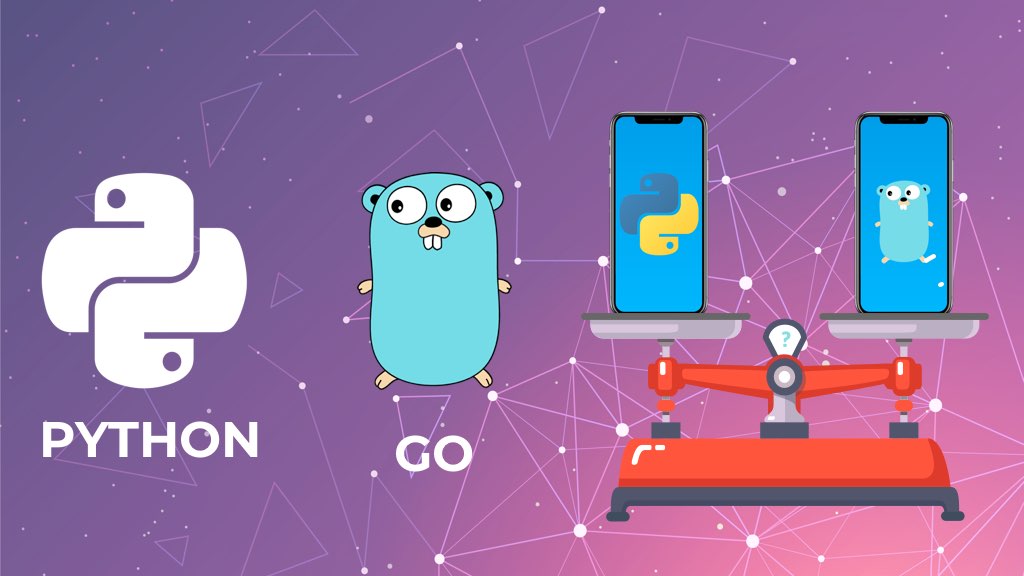Go vs Python 🐍
 Divakar
Divakar
Both Python and Go are different, generally serving different purposes. Python is the primary language among data scientists, where Go is the language for server-side commands. Go is the language to use to run software. It is the faster language, performing at Java and C++ speeds.
Python is the language to use for readable, shareable code—hence the large community around it.
Technically, Go is a procedural, functional language built for speed, and Python is an object-oriented, imperative, functional, and procedural language. Go supports concurrency, the ability of an algorithm to run its steps out of order, and Python doesn’t.
If you’re choosing between Go and Python, it’s likely because both of these languages are quickly growing and extremely marketable. While Go trails behind Python in terms of its raw community code base, it’s rapidly becoming one of the most important languages in the market.
Python is two decades older than Go. But that doesn’t mean that Go is going to knock Python off of its throne. Today, we’re going to take a deeper look at Go language, Python, and when you should use one language over the other.
In short, if you are working with data and your audience is people, use Python. If you are working with servers, use Go.
A Python’s tale
Ask some developers and you will hear that there was nothing before Python and there will be nothing after it. Over the years, it has managed to gain a cult-like following because it is a very good programming language. The internet is filled with wonders created using Python.
Python is old, in terms of programming years. It was first conceptualized back in 1991. And with age comes certain advantages. It has a wide following which translates to it being stable and well documented. In most cases, you will find libraries for almost everything and code samples for just about everything you can think of. What this means for devs and businesses is that the choice of using Python comes with it a wealth of experience and coding just waiting to be accessed.
There are plenty of open-source projects that use Python as a base, so in most cases, you are not starting from scratch. It is well integrated into enterprise applications and can be used in machine language and AI applications. But it does have its downsides. For one, it is not ideal for memory-intensive tasks, a bit on the slow side for executions and unsuitable for mobile application development.
Speaking of Golang(Go)
Developed at Google back in 2009. Go was a solution to a problem. Its aim was to create a language that took away all the baggage and excesses found in languages such as C++. This gives it a performance and speed boost that makes working with it a delight. Plus, most developers picking up Go for the first time are not going to be left adrift as the familiar elements and ease of use would come as a pleasant surprise.
This is not to say the language is perfect in all cases. While it takes speed and elegance to the next level, it does, however, leave behind some a few things to be desired. For one, it does not have an extensive library, nor support for inheritance. In addition, there is no GUI library or object-oriented programming support. What it does have going for it is a lightweight thread (Goroutines), smart standard library, strong built-in security and is easy to code with minimal syntax.
Why use GO language?
Here, are important reasons for using Go language:
- It allows you to use static linking to combine all dependency libraries and modules into one single binary file based on the type of the OS and architecture.
- Go language performed more efficiently because of CPU scalability and concurrency model.
- Go language offers support for multiple libraries and tools, so it does not require any 3rd party library.
- It’s statically, strongly typed programming language with a great way to handle errors
Why use Python language?
Here, are reasons for using Python language:
- Python is a powerful object-oriented programming language.
- Uses an elegant syntax, making the program you write easier to read.
- Python comes with a large standard library, so it supports many common programming tasks.
- Runs on various types of computers and operating systems: Windows, macOS, Unix, OS/2, etc.
- Very simple syntax compared to Java, C, and C++ languages.
- Extensive library and handy tools for developers
- Python has its auto-installed shell
- Compared with the code of other languages, python code is easy to write and debug. Therefore, its source code is relatively easy to maintain.
- Python is a portable language so that it can run on a wide variety of operating systems and platforms.
- Python comes with many prebuilt libraries, which makes your development task easy.
- Python helps you to make complex programming simpler. As it internally deals with memory addresses, garbage collection.
- Python provides an interactive shell that helps you to test the things before its actual implementation.
- Python offers database interfaces to all major commercial DBMS systems.
Key Differences
Below mentioned are the key differences between Python and Golang:
- As Python is a scripting language, it has to be interpreted, while Golang is quicker most of the time as it does not have to count on anything at runtime.
- Python is an ideal language that comes equipped with an easy-to-understand syntax, making it more readable and flexible. Golang is also in the prime league when it comes to clear syntax, which holds zero unnecessary components.
- Python doesn’t come with a built-in concurrency mechanism, whereas Go is packed with a built-in concurrency mechanism.
- Talking about safety, Python is a well-typed compiled language thereby incorporating a layer of security, while Golang is very decent because every variable should have a type connected with it. It implies a programmer cannot give away the details, which will further lead to flaws.
- Python is less verbose compared to Go to accomplish the same functionality.
- Python comes with dozens of libraries as opposed to Go, but gradually Go is also improving in this area.
- Python still earns the upper hand when it comes to syntax, making it very user-friendly.
- Python is considered the best when you have to solve data science problems, while Go is best suited for system programming.
- Python is a dynamically typed language, while Golang is a statically typed language, which helps you to detect flaws at compile-time, further reducing serious glitches later in the production.
- Python is the best choice for basic programming. Python can become complex if one prefers to build complicated systems. But with Go, the same task can be executed quickly without getting into the subtleties of programming language.
- Python is more compact than Golang.
Which to choose?
While Python has remained a community favorite retaining the #2 spot in the first quarter of 2019 for the fastest programming language on GitHub in terms of pull requests (+17%), Golang isn’t so far behind and is hot on its heels at #4 (+8%). The choice between Golang vs Python becomes even more blurry. Regardless, there are a few things to be considered when selecting which might be right for you.
Scalability: Golang was created with scalability in mind. It comes with inbuilt concurrency to handle multiple tasks at the same time. Python uses concurrency but it is not inbuilt; it implements parallelism through threads. This means that if you are going to work with large data sets, then Golang would seem to be a more suitable choice.
Performance: Python is not known to be memory or CPU friendly but with its huge number of libraries, Python performs efficiently for basic development tasks. Golang comes with build-in features and it is more suitable for microservices software architectures.
Applications: Python shines when used to write codes for artificial intelligence, data analytics, deep learning, and web development. Whereas Golang has been used for system programming, it is loved by developers who use it for cloud computing and cluster computing applications.
Community & Library: As mentioned earlier, Python’s age gives it certain advantages. One of which is the number of libraries it has and the large community that supports it. Golang, on the other hand, is still a growing language and does not have the number of libraries and community support that Python commands. Yet we should not count Go out just yet. Its rate of growth and adoption is incredible and it is expanding every day.
Execution: If speed is the name of the game, then Golang wins by a mile.
After taking all these into account, your use case will be the determining factor in which language to adopt. Given a scenario where you are setting up a development team to create microservices, Golang would be the more reasonable choice here as its both fast, easy to code with and can scale excellently well. Python, on the other hand, is more geared towards AI, ML and data analysis.
So going head to head, Go would come out on top in most cases and is considered to be a valid alternative to using Python. Developers need to choose a programming language considering their nature and size of the development project as well as the skill set of those involved.
The good news, however, is that regardless of choice, both languages are ever-evolving. While Golang might seem like an obvious choice in most cases, the Python community isn’t just sitting back and doing nothing. Both languages are expanding and growing. This means that we will be seeing more functionality and improvement in the future.
Subscribe to my newsletter
Read articles from Divakar directly inside your inbox. Subscribe to the newsletter, and don't miss out.
Written by

Divakar
Divakar
Tech Lead 💻 | Python 🐍 | Go 🚀 | AWS ☁️ | AI 🤖 | OSS ❤️ Backend Dev 👨💻 | Cloud ☁️ | GenAI 🧠 | Mentor 🌱 | Builder ⚙️ Code. Cloud. Create. 💡 | Python 🐍 | Golang 🚀 | AI 🔍 Engineer @ Heart 💻 | OSS Contributor 🛠️ | AI Explorer 🤖 Python 🐍 + Go 🚀 | Tech Lead | Cloud Native ☁️ | OSS ❤️